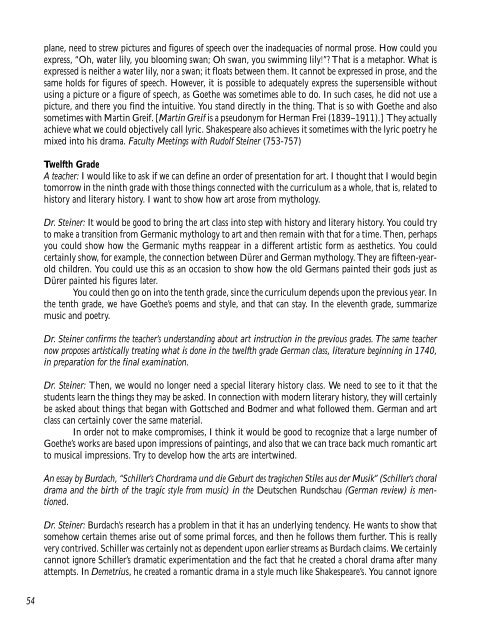Colloquium on English - Research Institute for Waldorf Education
Colloquium on English - Research Institute for Waldorf Education
Colloquium on English - Research Institute for Waldorf Education
Create successful ePaper yourself
Turn your PDF publications into a flip-book with our unique Google optimized e-Paper software.
54<br />
plane, need to strew pictures and figures of speech over the inadequacies of normal prose. How could you<br />
express, “Oh, water lily, you blooming swan; Oh swan, you swimming lily!”? That is a metaphor. What is<br />
expressed is neither a water lily, nor a swan; it floats between them. It cannot be expressed in prose, and the<br />
same holds <strong>for</strong> figures of speech. However, it is possible to adequately express the supersensible without<br />
using a picture or a figure of speech, as Goethe was sometimes able to do. In such cases, he did not use a<br />
picture, and there you find the intuitive. You stand directly in the thing. That is so with Goethe and also<br />
sometimes with Martin Greif. [Martin Greif is a pseud<strong>on</strong>ym <strong>for</strong> Herman Frei (1839–1911).] They actually<br />
achieve what we could objectively call lyric. Shakespeare also achieves it sometimes with the lyric poetry he<br />
mixed into his drama. Faculty Meetings with Rudolf Steiner (753-757)<br />
Twelfth Grade<br />
A teacher: I would like to ask if we can define an order of presentati<strong>on</strong> <strong>for</strong> art. I thought that I would begin<br />
tomorrow in the ninth grade with those things c<strong>on</strong>nected with the curriculum as a whole, that is, related to<br />
history and literary history. I want to show how art arose from mythology.<br />
Dr. Steiner: It would be good to bring the art class into step with history and literary history. You could try<br />
to make a transiti<strong>on</strong> from Germanic mythology to art and then remain with that <strong>for</strong> a time. Then, perhaps<br />
you could show how the Germanic myths reappear in a different artistic <strong>for</strong>m as aesthetics. You could<br />
certainly show, <strong>for</strong> example, the c<strong>on</strong>necti<strong>on</strong> between Dürer and German mythology. They are fifteen-yearold<br />
children. You could use this as an occasi<strong>on</strong> to show how the old Germans painted their gods just as<br />
Dürer painted his figures later.<br />
You could then go <strong>on</strong> into the tenth grade, since the curriculum depends up<strong>on</strong> the previous year. In<br />
the tenth grade, we have Goethe’s poems and style, and that can stay. In the eleventh grade, summarize<br />
music and poetry.<br />
Dr. Steiner c<strong>on</strong>firms the teacher’s understanding about art instructi<strong>on</strong> in the previous grades. The same teacher<br />
now proposes artistically treating what is d<strong>on</strong>e in the twelfth grade German class, literature beginning in 1740,<br />
in preparati<strong>on</strong> <strong>for</strong> the final examinati<strong>on</strong>.<br />
Dr. Steiner: Then, we would no l<strong>on</strong>ger need a special literary history class. We need to see to it that the<br />
students learn the things they may be asked. In c<strong>on</strong>necti<strong>on</strong> with modern literary history, they will certainly<br />
be asked about things that began with Gottsched and Bodmer and what followed them. German and art<br />
class can certainly cover the same material.<br />
In order not to make compromises, I think it would be good to recognize that a large number of<br />
Goethe’s works are based up<strong>on</strong> impressi<strong>on</strong>s of paintings, and also that we can trace back much romantic art<br />
to musical impressi<strong>on</strong>s. Try to develop how the arts are intertwined.<br />
An essay by Burdach, “Schiller’s Chordrama und die Geburt des tragischen Stiles aus der Musik” (Schiller’s choral<br />
drama and the birth of the tragic style from music) in the Deutschen Rundschau (German review) is menti<strong>on</strong>ed.<br />
Dr. Steiner: Burdach’s research has a problem in that it has an underlying tendency. He wants to show that<br />
somehow certain themes arise out of some primal <strong>for</strong>ces, and then he follows them further. This is really<br />
very c<strong>on</strong>trived. Schiller was certainly not as dependent up<strong>on</strong> earlier streams as Burdach claims. We certainly<br />
cannot ignore Schiller’s dramatic experimentati<strong>on</strong> and the fact that he created a choral drama after many<br />
attempts. In Demetrius, he created a romantic drama in a style much like Shakespeare’s. You cannot ignore

















